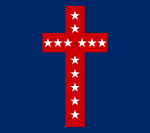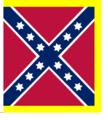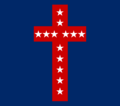Second Corps, Army of Tennessee facts for kids
Quick facts for kids Second Corps, Army of Tennessee |
|
|---|---|
 
Battle Flag under Bragg (left)
Battle Flag under Breckinridge (right) |
|
| Active | April 1862 – April 26, 1865 |
| Country | |
| Allegiance | |
| Branch | |
| Type | Army Corps |
| Role | Infantry |
| Size | 2-4 divisions |
| Part of | Army of Tennessee |
| Engagements | American Civil War |
| Commanders | |
| Notable commanders |
Maj. Gen. Braxton Bragg Lt. Gen. William J. Hardee Maj. Gen. John C. Breckinridge Lt. Gen. John Bell Hood Lt. Gen. S.D. Lee Lt. Gen. A.P. Stewart Maj. Gen. Edward Johnson Lt. Gen. D.H. Hill |
The Second Corps, Army of Tennessee was a large group of soldiers in the Confederate Army. They fought during the American Civil War. This group was like a big team, made up of several smaller teams called divisions. They played an important role in many major battles.
Contents
How the Second Corps Was Formed
The Second Corps was first put together in April 1862, right before a big battle called Shiloh. It was created by combining two existing groups of soldiers. One group was called Daniel Ruggles' Alabama Division. The other was Braxton Bragg's Army of Pensacola.
The Corps was being organized in Corinth, Mississippi. It became known as the II Corps of the Army of the Mississippi. At first, it had two main parts, or divisions. One division was led by Jones Withers. The other was led by Daniel Ruggles.
The II Corps was very large, with about 22,000 soldiers. This made it the biggest group in the Confederate Army at that time. Braxton Bragg was put in charge of this powerful new Corps.
First Battle: Shiloh
The Second Corps' first big test was at the Battle of Shiloh. They started strong, pushing back a Union division led by Benjamin Prentiss. But then, Prentiss and another general, Wallace, set up a strong defense. This spot was known as the "Hornet's Nest."
General Bragg's soldiers attacked the Hornet's Nest for hours. They faced heavy fighting and many soldiers were hurt. Even after they finally forced Prentiss's men out, the Second Corps was very disorganized. They were kept out of the main fighting for the rest of the first day. They fought briefly on the second day.
After Shiloh, many officers were hurt or killed. It took several months for the Corps to get back into shape. They then took part in the Corinth Campaign. Later, they were reorganized again for a plan to invade Kentucky in September 1862.
Changes and Reorganizations
After the Corinth Campaign, the II Corps was changed again. It still had two divisions. Patton Anderson led the first, and Simon Buckner led the second. William Hardee became the new leader of the Corps. Braxton Bragg was promoted to lead the entire army.
The Corps did not see much action at the Battle of Perryville. The whole army wasn't even there for the fight.
More Changes and New Leaders
The Corps and the entire army were reorganized once more. John C. Breckinridge and his division joined the Corps. They had fought at Shiloh but missed Perryville. His division added 11,000 men, making the Corps much stronger.
Anderson's division was split up. A new division from Kirby Smith's Army, led by John Mcown, joined the Corps. Buckner's division was then led by Patrick Cleburne, a very skilled commander. In total, the Corps had about 25,000 soldiers.
Battles in Tennessee
After all the changes in late 1862, the Army of Tennessee was ready for action. The Second Corps was a key part of this. Their next big fight was at Murfreesboro, in the Battle of Stones River.
The battle started when William Rosecrans and his Union Army of the Cumberland marched towards Bragg's army. Bragg ordered an attack on the Union right side. Hardee's Corps led the charge early in the morning. McCown's division attacked first, pushing the Union forces back over a mile.
The Second Corps was tired but had made great progress. However, other Confederate leaders did not follow up on their success. The II Corps had to fight again later to push back another Union division. So far, the battle was a Confederate success, mostly thanks to Hardee and the II Corps.
The Final Days at Stones River
Instead of continuing the attack, Bragg waited a day. Then, on January 2, he ordered Breckinridge's division from the II Corps to attack the Union left side. This attack was over open ground and a river. Breckinridge, Hardee, and other officers disagreed with this plan, but Bragg insisted.
The attack was very difficult. Bragg decided to retreat the next day. The II Corps acted as the rear guard, protecting the army as it pulled back.
Chickamauga and Chattanooga
The Corps was reorganized again after Stones River. Alexander Stewart's division joined the II Corps. However, Breckinridge and his division were sent away to help with the Siege of Vicksburg.
When Breckinridge returned, there were disagreements with General Bragg. Hardee and McCown were removed from their commands. The Corps was reorganized once more. Daniel Harvey Hill took command. He came from the Army of Northern Virginia and proved to be a very good leader for the Corps.
The Corps now had divisions led by Stewart, Cleburne, and Breckinridge, totaling about 20,000 men. McCown's old division was moved to a reserve group.
Fighting in Georgia
After some time, Bragg's army was pushed out of Chattanooga. But in north Georgia, Bragg prepared for a counterattack. More troops joined the army from different states.
The army was reorganized again. Hill lost Stewart's division, but he still had Cleburne and Breckinridge. The Corps fought hard at the Battle of Chickamauga. They attacked the Union left side and helped break through their lines, leading to a Confederate victory.
The Corps suffered many losses and was exhausted. Hill and other officers wanted to chase the defeated Union army, but Bragg refused. Because of this, Bragg removed Hill and several other officers from their commands.
The Battle of Chattanooga
At Chattanooga, the Corps was reorganized again. Breckinridge took command of the Corps. Cleburne's division, a strong part of the II Corps, was moved to another Corps. Other divisions were moved in and out. At one point, the Corps had about 28,000 men, but this number dropped to 23,000.
During the battle, the II Corps was positioned in the center on Missionary Ridge. Union forces attacked and broke through the II Corps, causing them to retreat in confusion. While not many soldiers were lost, the battle hurt the morale of the Confederate army.
The Atlanta Campaign
In December, Joseph E. Johnston took command of the army, replacing Bragg. Although he wasn't blamed for Chattanooga, John C. Breckinridge was replaced as Corps commander by John Bell Hood. Hood had come from the east with another large group of soldiers.
The Corps was mostly the same as it was at Chattanooga. However, Bate's division was exchanged for Carter Stevenson's division. By this time, none of the original units that formed the II Corps were still part of it.
The Corps fought in all the battles of the Atlanta Campaign. They played key roles at Resaca and New Hope Church. At Kennesaw Mountain, the soldiers of the II Corps went against orders. They attacked and pushed back Union forces, showing great determination.
Changes in Leadership and Heavy Losses
Once Hood took command of the entire army, the Corps went through many leadership changes. Stewart, Stevenson, Cheatham, Hindman, and finally Stephen D. Lee all commanded the Corps within just three months. The Corps fought very hard at the Battle of Atlanta and Ezra Church, where they suffered many losses.
The Invasion of Tennessee
After William T. Sherman captured Atlanta, Hood led his army north into Tennessee. The II Corps was still commanded by S.D. Lee. Its division leaders were Stevenson, H.D. Clayton, and Edward Johnson. Johnson was a newly exchanged prisoner of war.
The Corps marched north but missed the intense fighting at Franklin. This absence cost Hood the battle. For the first time, the II Corps' actions (or lack thereof) directly led to their commander losing a battle.
At Nashville, the Corps was in the center. They were attacked by George Henry Thomas, an old opponent. The II Corps was pushed back and then moved to the right side of the army. The Confederate soldiers, who were starving, could not defend well. This led to another loss for Hood.
Fighting in the Carolinas
After the defeat at Nashville in early 1865, the Confederate Army was losing hope. Hood resigned, and Joseph Johnston took command again. The Corps was reorganized once more. Stevenson, Clayton, and Stovall commanded the divisions. Johnson had been captured again.
The remaining soldiers of the army were sent to stop Sherman in the Carolinas. In this campaign, D. H. Hill commanded the Corps again. At Bentonville, the Confederates planned to attack an isolated Union force. The II Corps led a flank attack, pushing the Union troops back for miles. They even cheered "Nashville" as they routed two divisions. Hill's leadership brought success to the Confederates. However, with Lee's surrender in Virginia, the small Army of Tennessee, including the II Corps, also surrendered.
Images for kids



